-
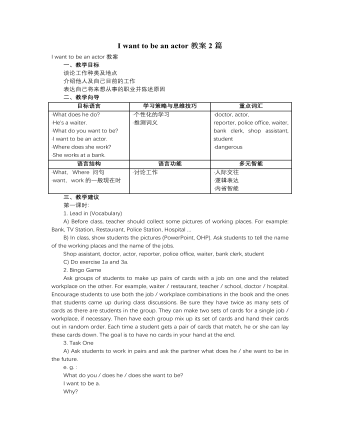
人教版新目标初中英语七年级下册I want to be an actor教案2篇
三、教学建议第一课时:1. Lead in (Vocabulary)A) Before class, teacher should collect some pictures of working places. For example: Bank, TV Station, Restaurant, Police Station, Hospital ...B) In class, show students the pictures (PowerPoint, OHP). Ask students to tell the name of the working places and the name of the jobs.Shop assistant, doctor, actor, reporter, police office, waiter, bank clerk, studentC) Do exercise 1a and 3a.2. Bingo GameAsk groups of students to make up pairs of cards with a job on one and the related workplace on the other. For example, waiter / restaurant, teacher / school, doctor / hospital. Encourage students to use both the job / workplace combinations in the book and the ones that students came up during class discussions. Be sure they have twice as many sets of cards as there are students in the group. They can make two sets of cards for a single job / workplace, if necessary. Then have each group mix up its set of cards and hand their cards out in random order. Each time a student gets a pair of cards that match, he or she can lay these cards down. The goal is to have no cards in your hand at the end.3. Task OneA) Ask students to work in pairs and ask the partner what does he / she want to be in the future.e. g. :What do you / does he / does she want to be?I want to be a.Why?Because it's (adj).B) Vocabulary: Section B, 1a4. Homework 1.2.
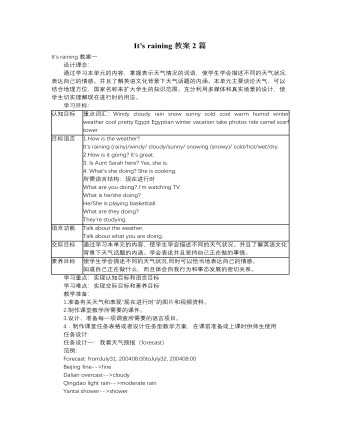
人教版新目标初中英语七年级下册It’s raining教案2篇
1 Each group choose one place to describe and what you are doing in it Choose one place, and describe what they are doing 2 Move around the room and give suggestions Talk about it and write it down 3 Ask one to show their works and act it Choose one of each group to make a report 4 Evaluate the best group and the best reporter Choose the best one Homework Ask your friends their ideal place and write about it教学反思:新课程标准中强调学生在课堂中的主体地位,在综合课中他们的主体地位就更加突出。在各个活动中给不同程度的学生不同层次的任务,让各层面的学生都有表现发挥的机会,从而产生对英语的兴趣。使用照片图片多媒体来辅助教学,效果更好。同时让了解其他国家风景,风俗的同学介绍ideal place,增加学生的背景知知识,实现跨学科交流的目的。教案点评:采用任务型教学模式,在各个活动中给不同程度的学生不同层次的任务,让各层面的学生都有表现发挥的机会,从而产生对英语的兴趣。使用照片图片多媒体来辅助教学,效果更好。让了解其他国家风景,风俗的同学介绍ideal place,增加学生的背景知识,实现跨学科交流的目的。
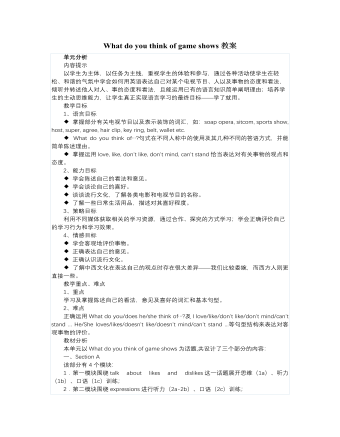
人教版新目标初中英语七年级下册What do you think of game shows教案
五、教学Section B-2c1. Pair work: What do you think of the belt/sunglasses/…? What does your father/mother/… think of your scarf/belt…?2. Group work(1). Teacher shows some different kinds of school uniforms (制服)and asks : “ What do you think of your school uniforms? If you have a chance to choose your school uniforms, what kind would you like to choose?”(2). Discuss in groups.(3).Get some Ss to report in class.说明:这一步旨在让学生运用已有的语言知识谈论对事物的看法和意见,并简单阐明理由,培养学生的主动思维能力和运用英语的能力。六、教学拓展调查电视节目的收视率任务:调查你周围的人对现在各种电视节目的反响。活动过程:1.教师布置任务,让学生调查周围的人(包括他的亲戚朋友和邻居)喜欢收看哪方面的电视节目。2.学生进行调查活动,运用本单元所学的句型What do you think of….? (Why?)What's your favorite game shows?What do you think of talk show?I doesn’t mind it.I like it.I love it.I can’t stand it.3.记录下排在前10位的TV Program,填写调查表,比较其收视率。

人教版新目标初中英语七年级下册Why do you like koalas教案2篇
单元整体说明(一)单元教材分析本单元的核心话题是描述动物和表达个人喜好,以及句式why do you like…? Because…。这也是本单元的教学重点。通过本单元的学习,学生应能较流利地运用所学词汇和句型描述动物,表达个人喜好。(二)单元知识结构1.词汇动物名称 tiger, elephant, koala, dolphin, etc.词汇描述性形容词: smart, cute, ugly, clever, shy, etc.国家名: Australia, South Africa2.句型Why do you like koala hears? Because they are cute.Where are pandas from? They're from China.What animals do you like? I like dolphins.(三)单元整体目标1.Master the vocabulary2.Master and use: Why do you like koalas? Because they am cute.Where are pandas from? They're from China.What animals do you like? I like dolphins.(四)单元教学重难点一览(五)单元学情分析学生此前已经学过由why, where, what 引导的特殊疑问句句型,具有了学习本单元知识的认知前提。形形色色的动物能激发学生的好奇心,产生了解它们的欲望,这有利于本单元知识的教学和学生学习兴趣的培养。

人教版新目标初中英语八年级下册Have you ever been to an amusement park教案
(1)Have you ever been to …? Yes, I have. / Yes, I have ever been to …No, I haven’t. / No, I have never been to …(2)When did you go there? I went there last year. (3)I have never been to a water park. Neither have I. I have ever been to an amusement park. So have I. (4)How long have you been studying English? I’ve been studying English since nine o’clock. I’ve been studying English since I came back home. I’ve been studying English for five hours. (5)What’s that? It’s an amusement park in Japan. I’ve never been to an amusement park like it before. It’s fun to learn another language. Let’s go tonight. Isn’t this great?space museum, amusement park, water park, South America, Peru, Holland, European culture, tour guide, flight attendant, musical instrument, more than, be from, get to, take lessons, neither, discover, graduate, change
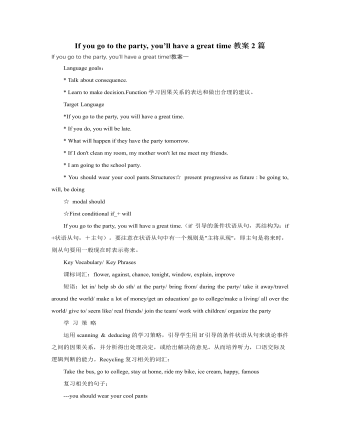
人教版新目标初中英语八年级下册If you go to the party, you’ll have a great time教案2篇
区分宾语从句、定于从句和状语从句宾语从句和状语从句,都叫做主从复合句。宾语从句主要是中考必考的,是初中阶段必掌握的从句,宾语从句主要是掌握三要素,所谓宾语从句,就是宾语在主从复合句当中充当宾语的一个句子,叫做宾语从句。主句的谓语动词是及物动词,后面如果是词或者是短语的话,是简单句,如果是句子的话,肯定是宾语从句。I know that he good at English.就是宾语从句,三要素,一要素是要注意连词,连词一共学了三类连词,一类连词是that口语当中可以省略,就像刚才说的那一句,I hear he is good at English.还有疑问代词、疑问副词,how where when,疑问代词、疑问副词。还有一类连词weather是否的意思,不是状语从句当中的如果,这一定要和如果区分开,这是是否。I don't know if he interested at English。宾语从句要注意if是连词。第二要素是语序,要用陈述举语序。比如说你家有几口人,我们都说How many people are there in you family?但是这是简单句,一旦说成宾语从句,你可以告诉我你家有几口人吗?Could you tell me how many people there are in you family ?
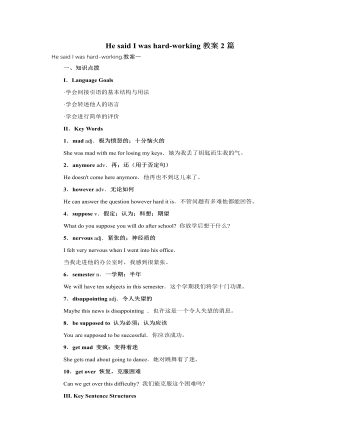
人教版新目标初中英语八年级下册He said I was hard-working教案2篇
This activity introduces some new vocabulary and provide oral practice using the target language.Task 1 . Ask four students to stand in front of the class, and the teacher asks them the following questions as a reporter.1.What are you going to do when you grow up?2.What are you going to do next week?3.What are going to do after school?The students will give different answers, then ask a good student to report what they said.I am going to e a doctor.What did she say?----------She said she was going to be a doctor.I am going to have a party on Friday night.What did he say?-------He said he was going to have a party on Friday night.I am going to do my homework.What did she say ?------ She said she was going to do her homework.I am going home after school.What did she say?-----She said she was going home after school.Say In this unit we are going to learn to use words like to report what someone said.Task 2. Read the instructions. Then ask a student to read the four questions. And write the words on the Bb. Explain what soap opera is.Task 3. Ask the students to Look at the pictures, point out the TV screens in the picture. Ask one girl to read what Marcia said.What did Marcia say? She said She said she was having a surprise party for Lana on Friday night. Repeat the other pictures in the same way.Activity3. Listen and number the pictures in activity 1a.

人教版新目标初中英语八年级下册What were you doing when the UFO arrived教案2篇
(一).知识方面: 1.培养学生能运用过去进行时来描述、谈论过去某个时间正在发生的事情或动作的意识和能力,能就过去某个时间正在发生的动作做出正确的描述。 2.培养学生的想象力和角色扮演的合作能力。 3.培养学生讲述过去发生的事情经过的能力。能正确运用一般过去时来讲述故事。 (二).技能方面: 1.本单元的语言目标是Talk about past events and tell a story(谈论过去的时间和讲述一个故事),围绕这一目标,要涉及句型: What were you doing when the UFO arrived? ----I was sitting in the barber’s chair. The barber was cutting my hair. 因此必须学习standing、studying、cleaning、sleeping、cooking、making、eating、cutting、等表示地点的词,以便为上述句型提供语言材料。2.学习过去进行时的有关知识。Was/were+现在分词,是该时态的表达式。 3.在学习过程中,要区分The boy was walking down the street when the UFO landed.和While the boy was walking down the street, the UFO landed.这两种由when和while引导的状语从句的句型结构。注意它们的不同。

人教版新目标初中英语八年级下册Would you mind turning down the music教案
Step 4. Group work (4)1. Ask a pair of students to read the dialogue. Say, This activity provides speaking, listening and writing practice using the target language.2. Ask students to complete the work in groups.3. Check the answers with the whole class. 4. Explain some of the language points. Step 5. Word review (Self check 1)1. Ask students to read the words and the phrases given. 2. Fill in the blanks with proper forms of these words to complete the sentences. 3. Check the answers with the whole class. Homework:Do activity 2 on page 57 after class. Period 6Teaching aims: 1. Teach vocabulary words and the useful expressions. 2. Enable the students to learn etiquette in different culture. 3. Help the students learn how to behave politely in public places and in daily life. Teaching procedures:Step 1. RevisionHelp students to review the function of making requests through a free talk. Then lead them to the topic of etiquette. Explain the meaning of etiquette. Or, ask students to look it up in the dictionary. Step 2. Pre-reading (Section 1)1. Ask students to read the picture and make a list with their partner about how many rules of etiquette can be seen being broken.
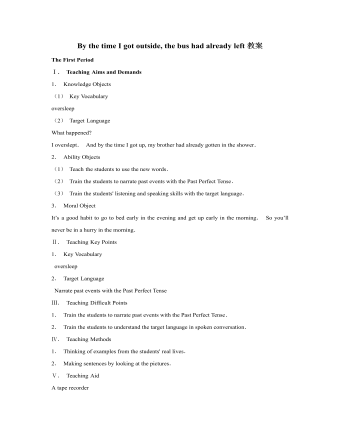
人教版新目标初中英语九年级下册By the time I got outside, the bus had already left教案
Ⅰ. Teaching Aims and Demands1. Knowledge Objects(1) Key Vocabularyoversleep(2) Target LanguageWhat happened?I overslept. And by the time I got up, my brother had already gotten in the shower.2. Ability Objects(1) Teach the students to use the new words.(2) Train the students to narrate past events with the Past Perfect Tense.(3) Train the students' listening and speaking skills with the target language.3. Moral ObjectIt’s a good habit to go to bed early in the evening and get up early in the morning. So you’ll never be in a hurry in the morning.Ⅱ. Teaching Key Points1. Key Vocabularyoversleep2. Target LanguageNarrate past events with the Past Perfect TenseⅢ. Teaching Difficult Points1. Train the students to narrate past events with the Past Perfect Tense.2. Train the students to understand the target language in spoken conversation.Ⅳ. Teaching Methods1. Thinking of examples from the students' real lives.2. Making sentences by looking at the pictures.Ⅴ. Teaching AidA tape recorderⅥ. Teaching ProceduresStep I Revision1. Revise the language points in Unit 8.Ask some questions like this: What volunteer work would you like to do?Help the students to answer, I’d like to…/I love to…/I hope to2. Practice the dialogue in Activity 3c on page 62 again. Get students to role play the similar dialogues with the following.

人教版新目标初中英语九年级下册Rainy days make me sad教案
1. 教材分析本单元以how do things affect you?为话题, 从颜色、天气、音乐、广告、产品等方面谈论了外界事物如何影响人的心情。要求学生掌握表达某物或某事给人带来的感觉、看法或影响等。共设计了四个部分的内容:Section A 该部分有4个模块:第一模块围绕Which restaurant would you like to go to?这一话题展开思维(1a)、听力(1b)、口语(1c)训练;第二模块围绕How does music affect you? 进行听力(2a-2b)、口语训练(2c);第三模块继续围绕how do colors in the restaurant affect you这一话题展开训练,训练形式为阅读和问题体验(3a)和小组活动(3b);第四模块仍就How do things affect you这一话题以调查的形式展开讨论。Section B该部分有4个模块:第一模块围绕产品广告对人们的影响这一话题以“配对”(1a)与“列举”(1b)两种形式展开训练;第二模块继续围绕How do things affect you? 进行听力(2a-2b)、口语对话训练(2c);第三模块围绕“Advertising”这一话题展开阅读(3a-3b)和写作(3c)训练;第四模块围绕How posters affect you这一话题以口语训练形式展开小组活动。
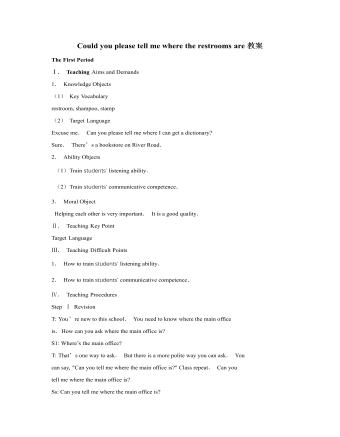
人教版新目标初中英语九年级下册Could you please tell me where the restrooms are教案
Step Ⅰ RevisionCheck homework. Ask a few students to read the article in 3a.Then ask a few students to read their guides.Step Ⅱ Part 1Look at the words in the box. Ask a student to read them. Make sure the students understand the meaning of the words. You are to fill in the blanks with the words. In some cases, students may need to use another form of the word, for example adjusting for tense or subject/ verb agreement.Ask students to fill in the blanks on their own.Check the answers. Step ⅢPart 2Go through the instructions with the class.Look at the example with the students.Ask students what the answer would be.Ask a student to read the question and answer it.Excuse me, could you tell me where the bank is, please?The bank is across the street from the shopping malt.Get students to complete the work in pairs.Check the answers. Ask a few students to read their questions.Step Ⅳ Just for Fun!Ask all the students to read the conversation. Ask: What is funny about this cartoon? Help students to explain. A Martian is a person from the planet Mars.There is no such thing as Martian food on Earth, and the clerk looks silly because he is trying to think of where there is a Martian restaurant.Invite some pairs of students to present this conversation to the rest of the class.Step Ⅴ Summary and HomeworkIn this class, we’ve done much writing practice using the key vocabulary words and the target language presented in this unit. After class, please finish the questions in 2 in your exercise books. Then finish the exercises on pages 47~48 of the workbook as well.The Seventh Period Ⅰ Teaching Aims and Demands1. Knowledge Objects(1) Key Vocabularyimage, adventure, jealousy, hero, crime, journey, brave, no longer, show interest in, take it easy, become interested in, plain looks(2)Text:Grown-ups like cartoons, too.2. Ability Objects(1) Fast-reading to get a general idea of the text.(2) Careful-reading to get the detailed information in the text.
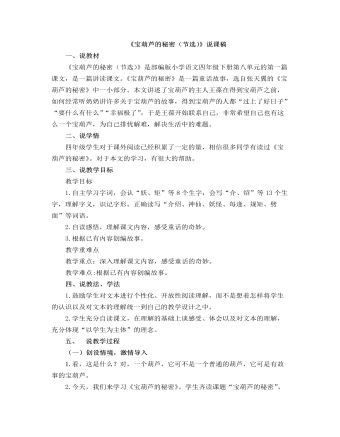
部编人教版四年级下册《 宝葫芦的秘密(节选)》说课稿
三、说教学目标教学目标1.自主学习字词,会认“妖、矩”等8个生字,会写“介、绍”等13个生字,理解字义,识记字形。正确读写“介绍、神仙、妖怪、每逢、规矩、劈面”等词语。2.自读感悟,理解课文内容,感受童话的奇妙。3.根据已有内容创编故事。教学重难点教学重点:深入理解课文内容,感受童话的奇妙。教学难点:根据已有内容创编故事。四、说教法、学法1.鼓励学生对文本进行个性化、开放性阅读理解,而不是想着怎样将学生的认识以及对文本的理解统一到自己的教学设计之中。2.学生充分自读课文,在理解的基础上谈感受、体会以及对文本的理解,充分体现“以学生为主体”的理念。

(说课稿)部编人教版三年级下册《 慢性子裁缝和急性子顾客》
一、说教材《慢性子裁缝和急性子顾客》是统编小学语文三年级下册第八单元的第一篇课文,这篇课文讲述了急性子顾客让慢性子裁缝做衣服,结果到最后慢性子裁缝还没裁剪的事,告诉我们做事情要讲究效率,赶紧做完自己该做的事,才会有更多的时间去干其他事。不管干什么事情都要专心去做,不能磨磨蹭蹭浪费时间。本单元的主题是“有趣的故事,留下的不仅是开心的笑声,还有许多的思考”。本课紧扣单元主题,是一个十分幽默的故事,引人入胜的情节和别出心裁的结局充分体现了故事的精彩性和幽默性。二、说教学目标 1.会认“缝、箱”等12个生字,读准多音字“缝、夹”,会写“性,卷”等12个生字,正确读写“性子、布料”等词语。

部编人教版四年级下册《 宝葫芦的秘密(节选)》精彩片段说课稿
深入理解,探讨故事师:宝葫芦的主人是个什么样的人呢?你是从哪些语句中感受到的。生:宝葫芦的主人是一名普通的少先队员,名叫王葆。师:你从哪里得到这些信息的?生1:“我姓王,叫王葆。”师:为什么不说“我叫王葆”?生2:这样说,比较正式,有仪式感。生3:“可是我要声明,我并不是什么神仙,也不是什么妖怪。我和你们一样,是一个平平常常的普通人。”师:为什么说王葆说“我并不是什么神仙,也不是什么妖怪”?生:因为他和宝葫芦有故事,是传说中的那种宝葫芦和王葆发生过一些故事。出示:“至于宝葫芦的故事,那我从小就知道了。那是我奶奶讲给我听的。”师:奶奶给“我”讲了哪些故事?

部编人教版四年级下册《 “诺曼底号”遇难记》精彩片段(二)说课稿
师:对,镇定自若。(板书:镇定自若)这份镇定自若,别人能与他相提并论吗?(不能)4.你还能从这段话中读出什么来?妇女先走,船员断后。咱们常说女士优先,在灾难面前也做到让妇女先走,这叫什么?生:绅士风度。(板书:绅士风度)5.同学们,假如你就是哈尔威船长,面对混乱的人群,你准备怎样来下达这道命令?指名学生朗读。(师指导:场面混乱,情况危急。)师:在灾难面前,时间就是生命。师:这是庄严的指挥,这是威严的指挥。我们一起来读读。师:真好,读得好,脸部的表情也非常到位,满脸的威严,正因为这样,所以课文的作者雨果是这样评价船长的,再读。ppt:在英伦海峡上,没有任何一个海员能与他相提并论。(生齐读)师:不能与他相提并论的还有他的:忠于职守、镇定自若、绅士风度。这是咱们从第一幅画面中感受到的。

部编人教版四年级下册《 巨人的花园》精彩片段说课稿
师:巨人看见孩子们在花园里玩耍,大声叱责。请把巨人叱责的话找出来读一读。(生边读边画出巨人叱责孩子们的语句,文中主要有三句)师:读一读这三句话,联系上下文想一想:巨人说这些话的时候,心里可能是怎么想的?他说话的时候可能是什么样子的?生:巨人说:“你们在这儿干什么?”这时他可能瞪着眼睛,脸上通红通红的,双手叉着腰,心里想:这是我的花园!你们这些小家伙随便进来,真讨厌!生:巨人说:“我自己的花园就是我自己的花园。”这时候,比他刚回来时更烦,样子更凶。巨人肯定在想:我孤独地度过了漫长的寒冬,好不容易才盼来春天,你们这些小家伙又来了!这时,他可能攥着拳头,唾沫飞出老远。生:“除了我自己以外,我不允许任何人在里面玩。”巨人心里可能想,这是我的地方,我已经说了不让你们进来,你还敢进来!巨人说不定已经迈开大步准备去教训这个小男孩。

部编人教版四年级下册《 飞向蓝天的恐龙》精彩片段说课稿
师:是呀。早在19世纪,英国学者赫胥黎就注意到恐龙和鸟类在骨骼结构上有许多相似之处。在研究了大量恐龙与鸟类化石之后,科学家们提出,鸟类不仅和恐龙有亲缘关系,而且很可能就是一种小型恐龙的后裔。但相关化石一直没有找到。直到20世纪末期生:在课文中找出相关段落齐读。师:(投影出示再读)你读懂了什么?生:我知道了化石是首次发现,是在辽西发现……(学生交流)师:欣喜若狂,是什么意思?生:高兴到了极点,就要发狂了。师:研究者们为什么会如此地高兴?(设计意图:由点带面,通过重点词语的理解,感受科学家的艰辛与执着。)

部编人教版四年级下册《 纳米技术就在我们身边》说课稿
一、说教材《新奇的纳米技术》是部编版四年级下册第二单元的一篇讲读课文。这篇文章介绍了什么是纳米、纳米技术以及介绍了利用纳米技术可以改变我们的生活条件和医疗条件。写出了纳米技术的神奇。学习本课激发学生学科学、爱科学的浓厚兴趣。二、说教学目标、重难点 (一)说教学目标1.掌握新字、词。 2.了解科学小品文的文体知识。 3.抓住关键语句,有目的地筛选信息,了解纳米有关知识。 4.培养学生通过各种渠道收集信息的能力。 (二)说重难点教学重点: 1.抓住关键语句,有目的地筛选信息,了解纳米有关知识。 2.自主、合作探究“神奇”的具体体现。 教学难点: 1.培养学生通过各种渠道收集信息的能力。 2.有科学依据的大胆想象,培养学生的科学精神和创造能力。 三、说教法 1.通过查字、词典等工具书扫清阅读障碍。2.自主、合作探究“神奇”的具体体现。 3.体会深入浅出地介绍科学知识的方法。
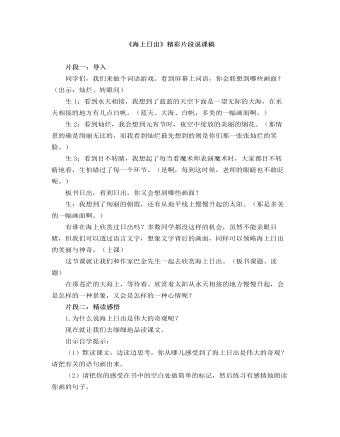
部编人教版四年级下册《海上日出》精彩片段说课稿
师:少了这两个词行不行?(不行。)为什么?生:转眼间写出了颜色变化的速度快,慢慢是指红霞扩散的速度慢。所以不能少了这两个词。师:既然颜色的变化是有快有慢,那我们在朗读的时候,速度也应该是——(有变化的 )。谁能带着你的感受来读一读。男生读。(你的朗读,让我们感受到了天空中色彩的瞬息万变。)女生读。(你甜美的朗读让我们感受到了红霞在天空慢慢晕地扩散。)齐读,透过文字,你能想象到什么样的画面?生:那浅蓝的天空和慢慢扩散的红霞让我感到这时的天空就好像是一幅美丽的水墨画。师:到底是学画画的孩子,有丰富的想象力。作者抓住了天空中颜色和光的变化,让我们感受到了海上日出是——生:伟大的奇观。(板书:颜色 光亮 变幻)看到天空中色彩的变幻以及那越来越亮的光,我知道——生:太阳要从天边升起来了,便不转眼地望着那里。透过“不转眼”你能体会到什么?(作者期待、盼望的心情。 生怕错过日出的每一个时刻。)是啊,此时,我们和作者的心情是一样的。

